"Representation Under Attack" through the lens of the collections and archives of the members of L'Internationale
This first online presentation by the confederation of L'Internationale of their collections considers the collections and archives through the lens of "Representation Under Attack". This chapter is the result and effect of the use and mode of reading of archives and collections to find traces of attacks and controversial approaches towards art and artists in relation to artistic freedom in all its forms. At the same time, it looks critically for evidence of actions that demonstrate the limits of museological and bureaucratic protocols from the perspective of the institutions themselves. These limits intentionally, or not, limit artistic freedom.
–Diana Franssen, Member of the Editorial Board L'Internationale Online, Curator at the Van Abbemuseum, Eindhoven
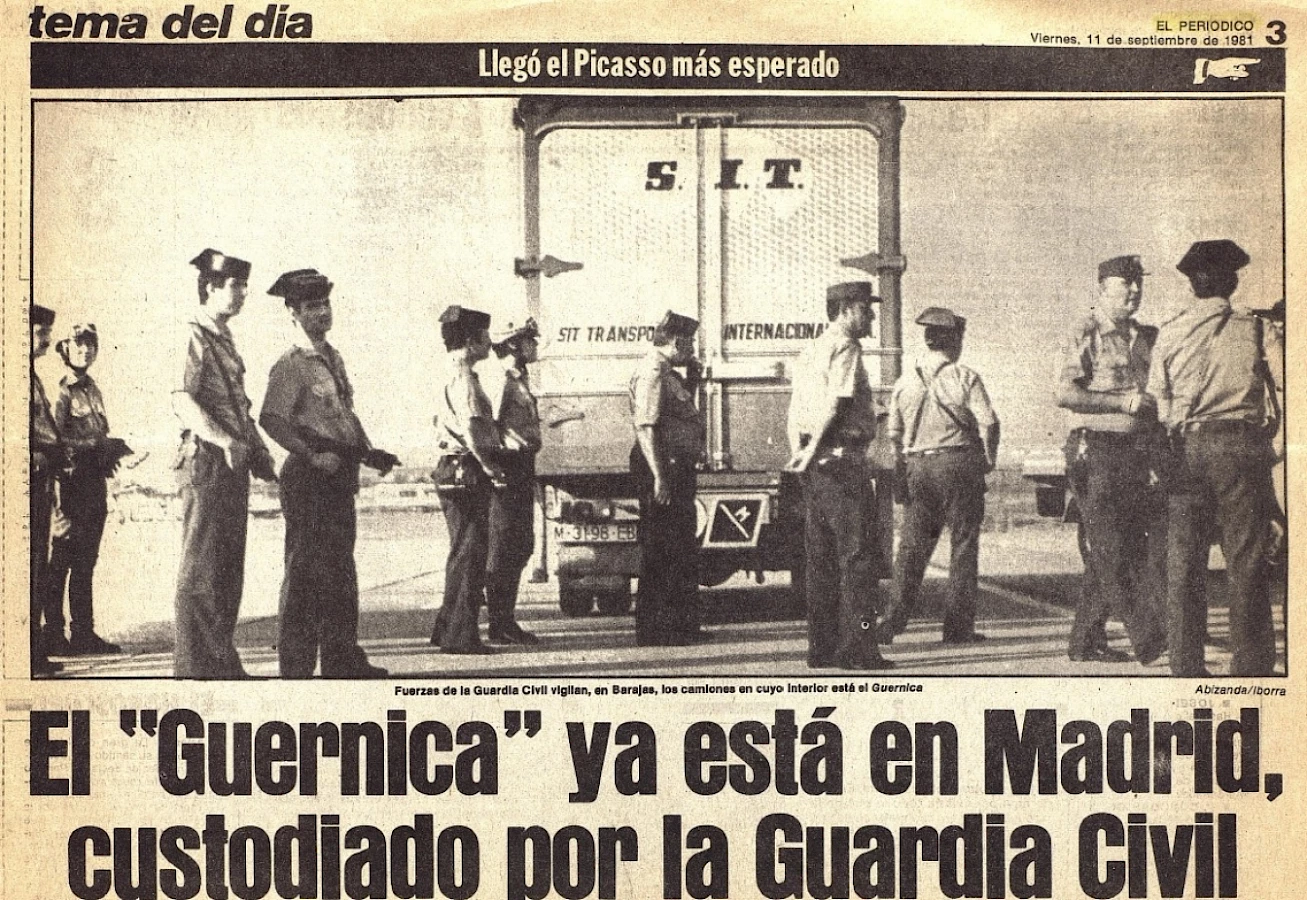
EL PERIÓDICO. Madrid edition, September 11, 1981. Photo: Abizanda/Iborra. Archive S.I.T. (Museo Reina Sofía).
FROM THE COLLECTION OF MUSEO NACIONAL CENTRO DE ARTE REINA SOFIA, MADRID
Pablo Picasso
Guernica, 1937
Oil on canvas, 349 cm x 776 cm
Following the dictator Francisco Franco's death in 1975, the Spanish Ministry of Culture started the devolution process for Guernica, Pablo Picasso's master piece, which had been on custody in the Museum of Modern Art in New York collection since 1944, having travelled around Europe and the United States in 1938 and 1939. The painting had been commissioned and paid for by the Spanish Republic in 1937, to encourage international support for the Republican cause during the Universal Exhibition in Paris that year. Considering the outcome of the Spanish Civil War, Picasso often expressed his will not to return the painting to the Spanish authorities until the end of Franco's dictatorship and the restoration of democracy in Spain. In 1981, Guernica arrived in Madrid amidst great expectations and excitement from the media. Its return represented a key moment in the "Transition", the process of restoration of the democratic State. Because of its political meaning and symbolic value, the painting functioned as a metaphor for the return of democracy itself.
Given the political assessment that the arrival of the work implied, and the fragility of the new democratic regime, the authorities were afraid that the painting could be attacked by fascist supporters. To prevent any possible attack, the transfer from the airport to the Casón the Buen Retiro (the palace next to the Museo del Prado, which was its first location) was executed with great security measures. Surrounded by police and civil guard corps members, Guernica was installed and displayed inside a box of armoured glass, with the surveillance of armed civil guards to prevent possible shooting or stabbing attacks. This protection urn could also be interpreted inversely as a way to protect the fragile social consensus of the Transition from the powerful partisan content of the work. Symptomatically, its shape resembled a ballot box.
–Jesús Carrillo, Editorial Board L'Internationale Online, MNCARS, Madrid
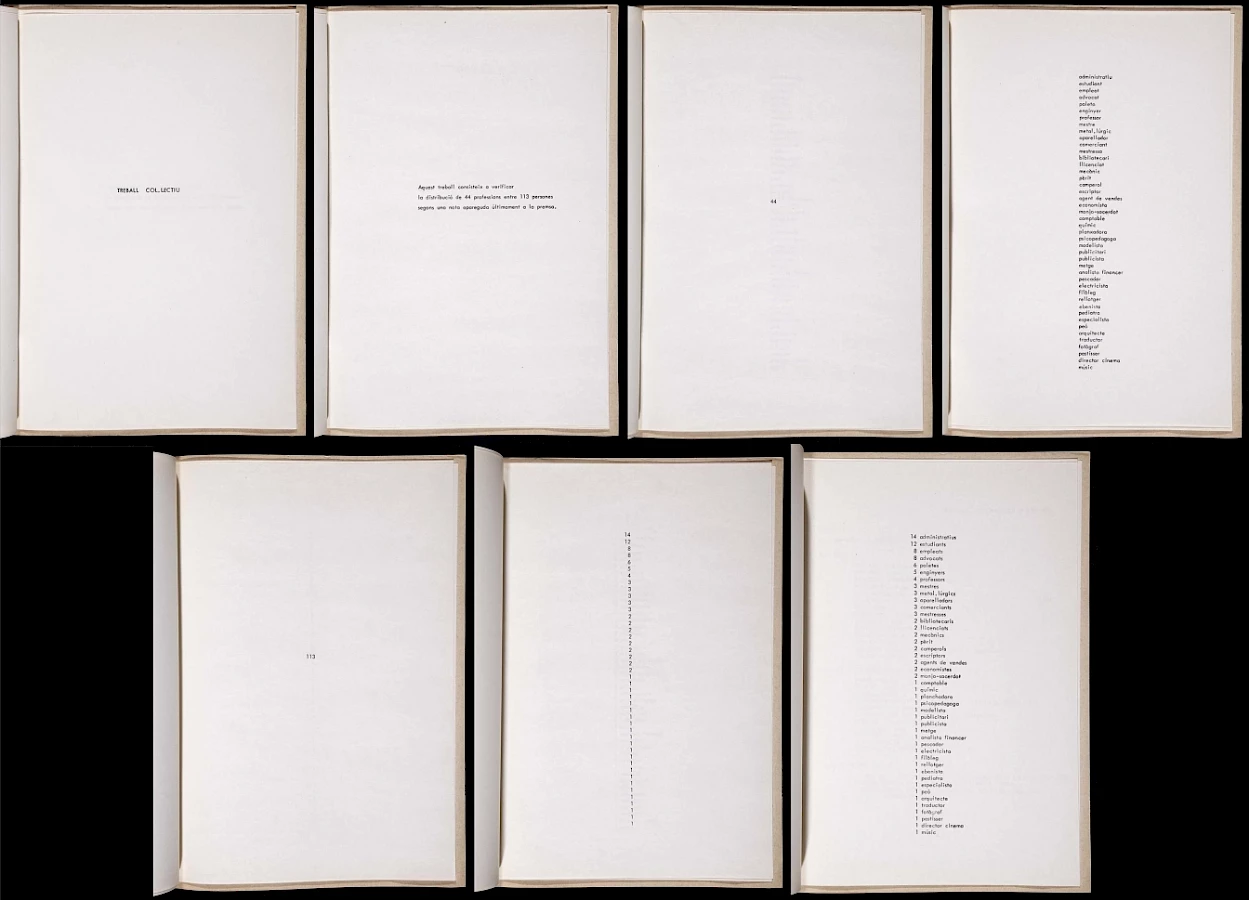
Grup de Treball, Treball col·lectiu que consisteix en verificar la distribució de 44 professions entre 113 persones segons una nota apareguda últimament a la premsa (Collective Work Consisting of the Distribution of 44 Professions among 113 People Based on an Item in the Press), 1973. Collection Museo Nacional Centro de Arte Reina Sofía. Donation of Grup de Treball, 2009.
Grup de Treball (F. Abad; J. Benito; J. Carbó; A. Fingerhut; X. Franquesa; C. Hac Mor; I. Julián; A. Mercader; A. Munné; Muntadas; J. Parera; S. Pau; P. Portabella; À. Ribé; M. Rovira; E. Sales; C. Santos; D. Selz; F. Torres; M. Costa)
Treball collectiu que consisteix en verificar la distribució de 44 professions entre 113 persones segons una nota apareguda últimament a la premsa [Collective Work Consisting in the Distribution of 44 Professions among 113 People Based on an Item in the Press], 1973
Seven typed sheets of paper, 29,5 x 21 cm each
Donation of Grup de Treball, 2009
The origin of this work can be traced to a key historical event in the fight against Franco: the police arrest of 113 members of the Catalonian Assembly, which two members of the Grup de Treball belonged to, and which included representatives of political parties and clandestine trade unions, as well as professional organisations and neighbourhood associations. This mass imprisonment took place in October 1973, inside the Santa Maria Mitjancera church in Barcelona. Using a language close to that of visual poetry, the work consists of a list that indicates the professions of all the 113 detainees. The artists use a pronounced seriality and formal schematism, in line with the semiotic language of so-called "ideological conceptualism", which conceived artistic work as an instrument of agitation. The piece was included in the catalogue of the 1973 Terrassa, Informació d'Art (Terrassa, Information of Art) exhibition, a folder or dossier-type publication, a format which the group most commonly presented their works in. This exhibition formed part of a series of meetings organised by the Grup de Treball at different locations throughout the Catalonian territory. These meetings focused on the idea of instituting a type of exhibition based on communication and information as a means to defend the social purpose of art. With this as a premise, the works were displayed next to stands full of reference books and photocopiers that were available for the public, who in turn were expected to participate dynamically and reflexively.
–Lola Hinojosa, Curator at MNCARS, Madrid
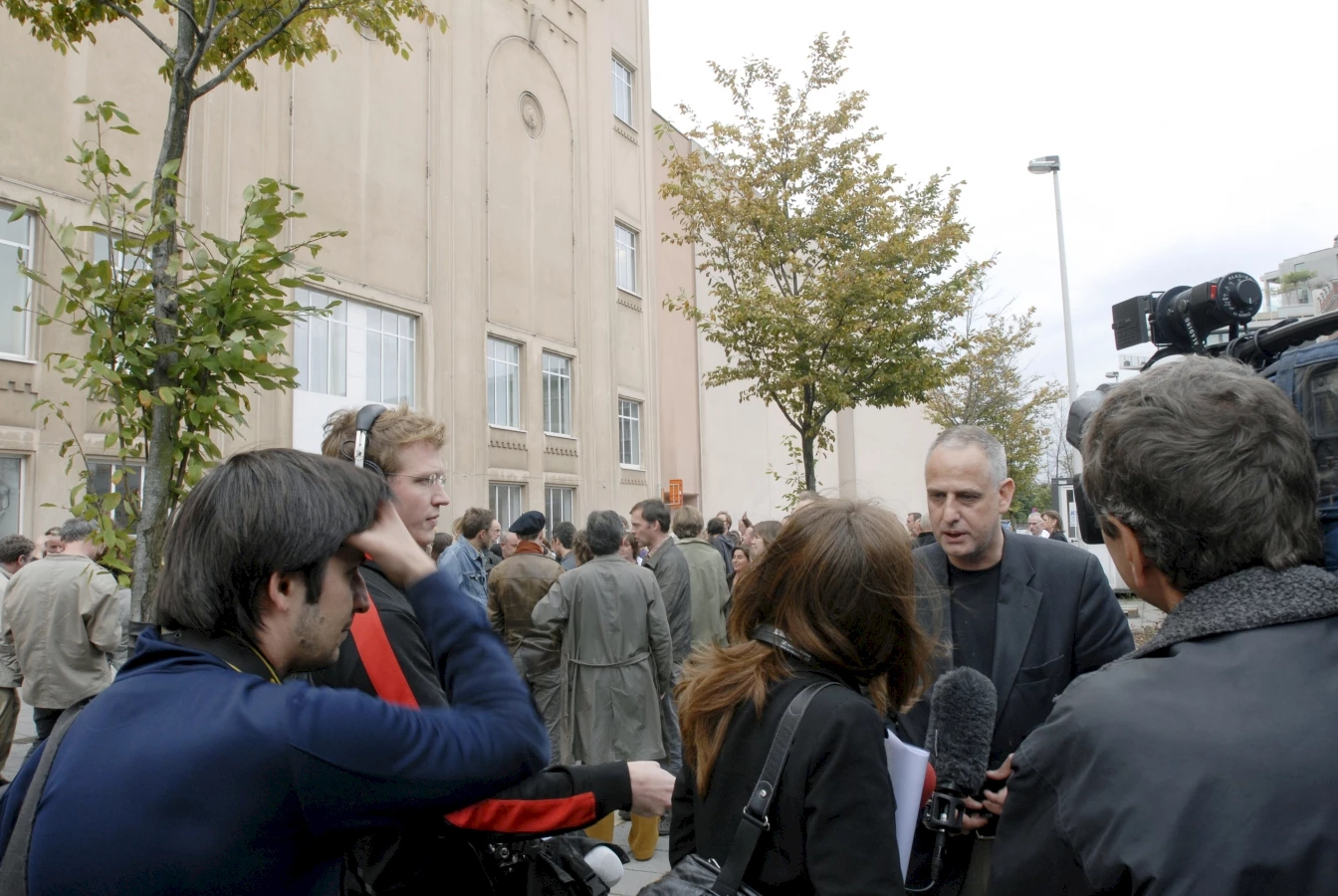
0110 – Fire Alarm. Painter Luc Tuymans explains the initiative to the press in front of Museum van Hedendaagse Kunst Antwerpen. October 5, 2006. Copyright: M HKA.
FROM THE COLLECTION OF M HKA, ANTWERPEN
0110 – Fire alarm
In 2006, the radical rightwing party Vlaams Belang – previously called Vlaams Blok which had been disbanded because of its overt racism – was threatening to gain absolute majority in the city election in Antwerp, the largest city in Flanders. The elections would turn out differently and prove to be the beginning of the demise of the party which has now shrunk to irrelevance. The cultural sector was of key importance in this turnaround. The main event was a series of free concerts in Antwerp, Brussels, Charleroi and Ghent, to promote tolerance and make a stance against racism, extremism and gratuitous violence. The initiator of the 0110 event was the renowned Antwerp rock band dEUS who performed in their home city for the first time in many years. On 10 October, the events were broadcast live on several television and radio stations and changed the atmosphere in the city. M HKA was the press centre for the Antwerp event. Painter Luc Tuymans rightfully thought the visual arts scene was not being very effective, and that an offensive attitude was needed following the concerts. M HKA proposed to take the notion of an emergency fire alarm literally and to turn it into a collective artwork. Artists were able to make inscriptions and many institutions set off their fire alarm at 3pm on Thursday 5 October, three days before the elections. The artist organisation NICC coordinated this initiative and more than a hundred museums, art centres and academies across the country participated. This became front page and prime time news.

Khaled Hafez, Revolution, 2006. Collection Museum van Hedendaagse Kunst Antwerpen, M HKA.
Moussem Collaboration
When the organisation of Belgian citizens of Moroccan origin asked M HKA for support regarding visual arts in 2006, they mentioned that they actually considered all the major cultural institutions to be entirely theirs. M HKA responded by proposing that they take over the museum for part of a season; what would they do then? The Moussem organisation responded that it would offer space to the smaller communities, which it did in 2007 in the period it 'owned' M HKA (15 March–20 May). This free zone included an Afghan New Year party one weekend, a reunion of people coming from Argentina on another, and so forth, with their own events and small exhibition programmes on each occasion. For one year, a group of young people – Moussem Club – analysedthe museum's collection with the artist Charif Benhelima and the museum staff. Together they prepared an exhibition titled UNTITLED in which Moussem Club presented their own selections, arguing why they had chosen certain works on small video screens. During the Mawazine Festival in 2010, this exhibition travelled to Rabat in Morocco. Moussem also proposed an exhibition of work by artists relating to Morocco, both living there and abroad. This was continued by various acquisitions, including a series of key works by Hassan Darsi and work by the Egyptian artists Khaled Hafez and Amal Kenawy that were presented. In his three-screen video Revolution (2006), Hafez designates ideology as one of the strongest forms of belief. Both a businessman and a religious fundamentalist are represented here as revolutionaries, in reaction to which a third protagonist, a soldier, kills them. The work functions as a classic triptych with three promises (social equity, liberty, unity) – promises that revolution cannot keep. Morocco, just like Egypt, is indeed a mental space, not a territory.
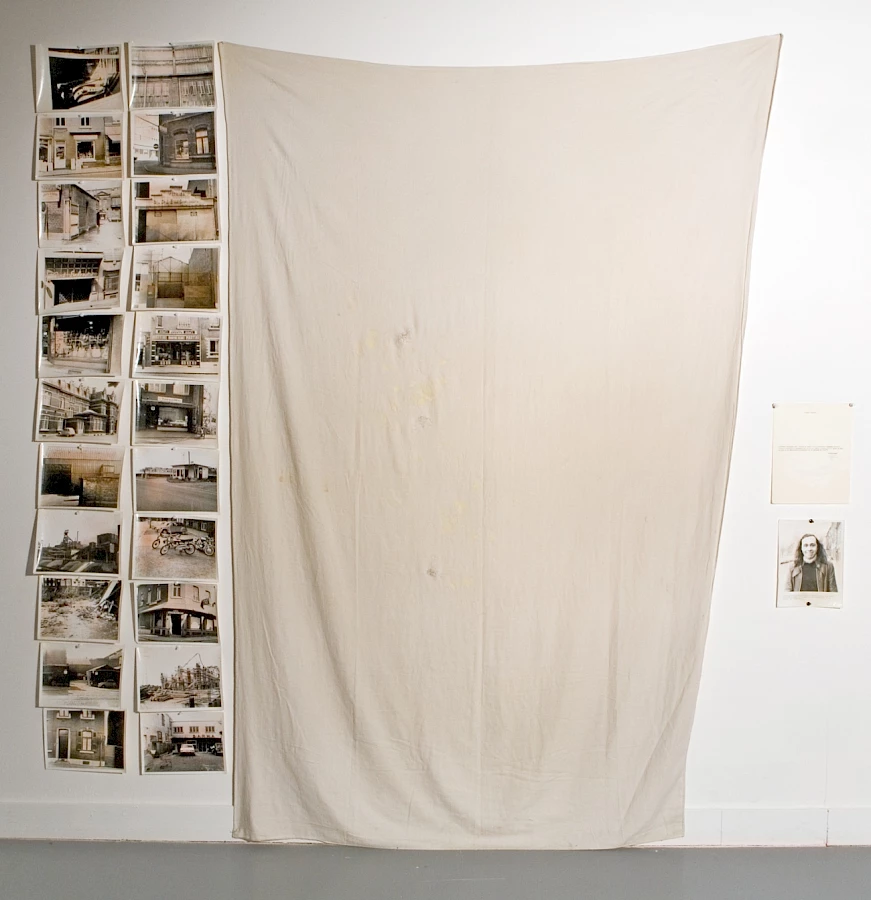
Jacques Lizène, Rapport d’un voyage, 1973. Collection Museum van Hedendaagse Kunst Antwerpen, M HKA.
Censured Work by Lizène Reconstructed
Calling himself the "mediocre little master from Liège" – a Belgian twist on Filliou's "genius without talent" – Jacques Lizène donated a key work to the Gordon Matta-Clark Foundation in 1980: Documents rapportés d'un voyage au cœur de la civilisation banlieue 1973, 74 et 75. The work consists of two parts: a narrative framework on the one hand, in which the rigorous black-and-white aesthetic resembles the standardised documentary tropes of "information art", and Robert Smithson's original post-industrial wasteland is replaced with the banlieue of Liège. On the other hand, a quasi-monochrome white bed sheet displaying the near-invisible traces of the artist's nocturnal masturbatory activity is a crass reminder of the pertinence of the body in all overly intellectualised art. When this work was first shown at the ICC (International Cultural Center, the institution that preceded M HKA) in the late 1970s, a local censor actually ordered its removal from the exhibition. When reassessing its collection of post-Second World War avant-garde, M HKA found that it held the original photos. They asked the artist to reenact the work, which he agreed to do. This white-on-white monochrome is now testament to suburban loneliness within the collection. Tellingly, censorship was no longer an issue when a far more graphic exhibition of Lizène's work was organised at the museum in the spring of 2009.
–Jan De Vree, Curator at M HKA, Antwerpen and Nav Haq, Member of the Editorial Board L'Internationale Online, Curator at M HKA, Antwerpen
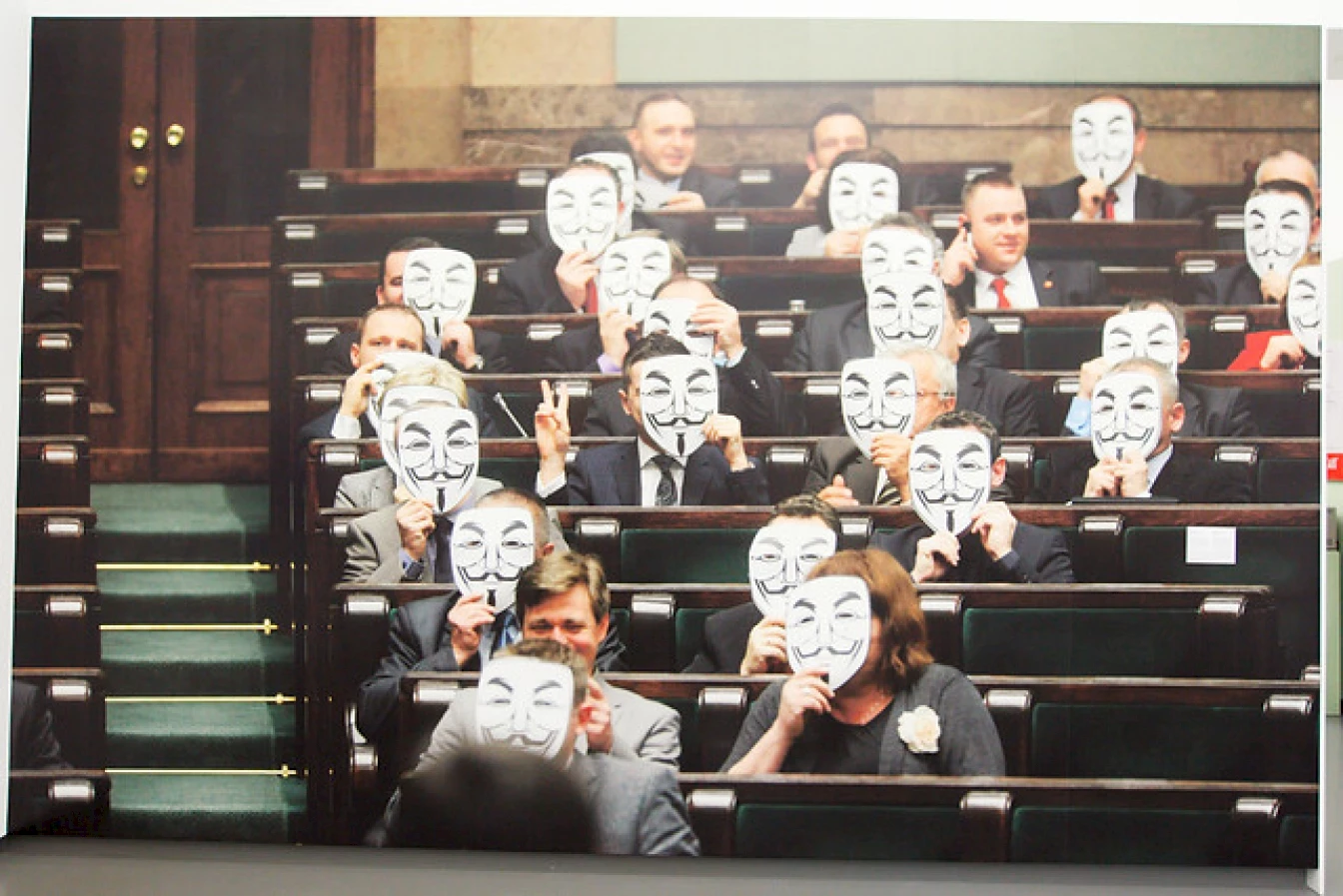
Jonas Staal, Politiek kunstbezit II: Vrijdenkersruimte, 2010. Installation with paintings, posters, photo's, cartoon, documentary, time line, publication. Courtesy Van Abbemuseum, Eindhoven; Photographer: Bram Saeys.
FROM THE COLLECTION OF THE VAN ABBEMUSEUM, EINDHOVEN
Jonas Staal (1981 Zwolle, The Netherlands)
Politiek kunstbezit II: Vrijdenkersruimte, 2010
Paintings, posters cartoons, documentation, timeline
Purchase: 2011, Inv.nr. 2993.
In 2008, the liberal-conservative Popular Party for Freedom and Democracy (VVD) and the extreme nationalist Freedom Party (PVV) opened the Freethinkers' Space. In their offices in The Hague, they created a space for provocative art, cartoons and other public opinions that aggressively critiqued Islam and were considered problematic or even censored by civil society. When a left-liberal Groen Links (Green Left) MP, Tofik Dibi, challenged them also to include works criticising the leader of the populist PVV Geert Wilders and the expressly pro-Israel stances of both parties (the PVV more so than the VVD), the PVV quit.
In 2010, artist Jonas Staal decided to reactivate and continue the original Freethinkers' Space for an exhibition at the Van Abbemuseum. The project was later acquired by the museum for its collection. The project entitled Art, Property of Politics II: Freethinkers' Space consists of artworks, a publication with documentation and accompanying texts, the Freethinkers' library and recordings of the opening speeches by the founders Mark Rutte (VVD) and Fleur Agema (PVV).
In 2012, Jonas Staal re-enacted the space in several locations. At the Van Abbemuseum, Groen Links MP Jesse Klaver and Eindhoven city council member for the progressive liber D66 Rogier Verkroost put together an exhibition with examples of art, opinions and events that touched on issues of censorship.
The original Freethinkers' Space contained works by Theo van Gogh, Gregorius Nekschot, Ellen Vroegh, Aram Tanis, Jaffe Vink, T., Internationale Socialisten, Kurt Westergaard and Gerrit van Kralingen.
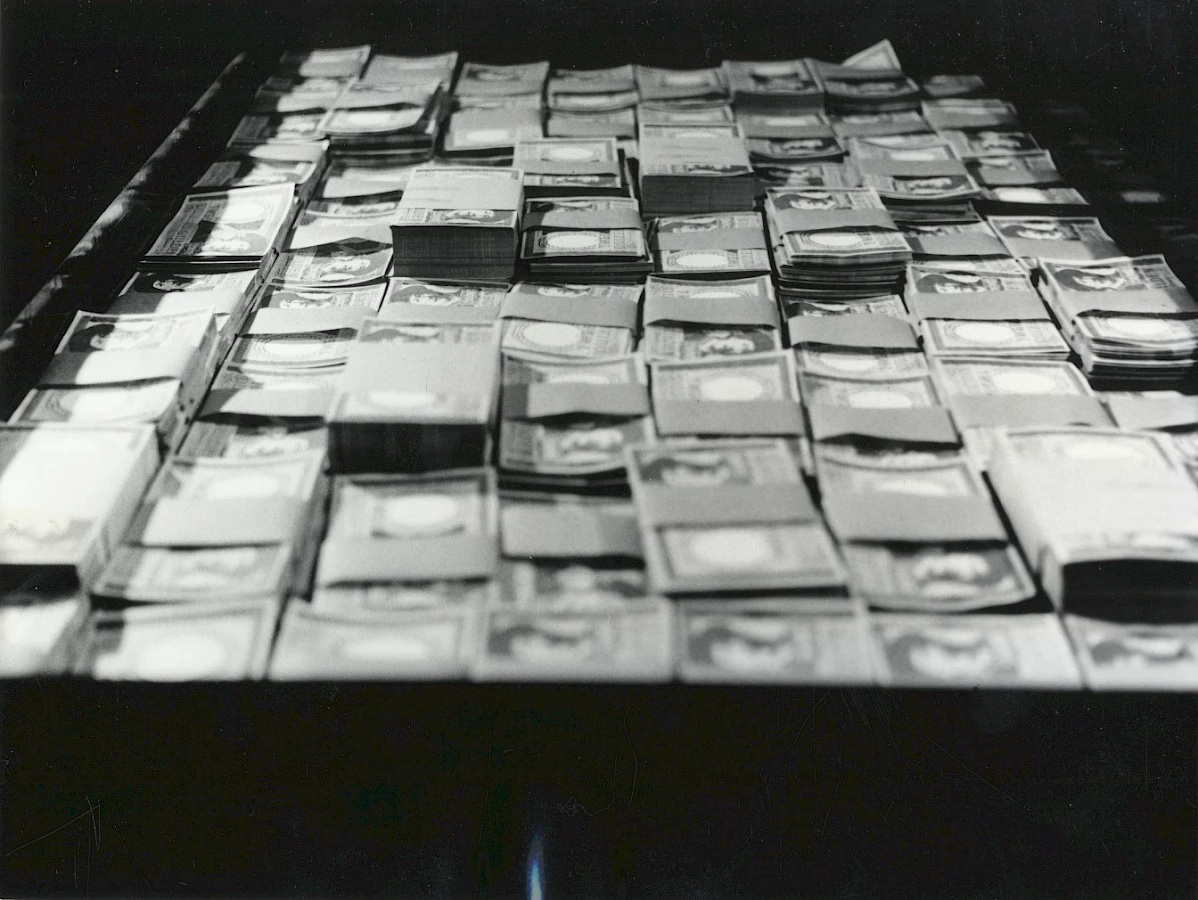

Futurologists 2000, Requiem for a Defence Budget, 1970. In the exhibition Georg Grosz. The Face of the Ruling Class (May 1 1970 – June 14 1970). Courtesy: Van Abbemuseum, Eindhoven; Photographer: Van den Bichelaer.
FROM THE ARCHIVE OF THE VAN ABBEMUSEUM, EINDHOVEN
An invited action group
Futurologists 2000's Requiem for a Defence Budget (1970) in the exhibition Georg Grosz The Face of the Ruling Class (1 May 1970 – 14 June 1970)
In Spring 1970, former Van Abbemuseum director Jean Leering gave contemporary meaning to a Georg Grosz exhibition entitled The Face of the Ruling Class by combining it with a presentation by Futurologists 2000. This was the name used for the occasion by a radical left-wing action group, the Nijmegen offshoot of the national De Kabouters (The Gnomes, as in garden gnomes) movement, which also operated under the names of Omroep (2000) and Commune 2000.
Requiem for a Defence Budget was an installation comprising four coffins each containing a bundle of forged 2000 guilder banknotes, worth four billion guilders, or the equivalent of the Dutch defence budget. The government supported America in the Vietnam War at the time and opposed the Second Chamber's appeals to urge America to end the bombing. Forged banknotes had often been used before as 'social dynamite' by the Orange Free State (the political mouthpiece of De Kabouters) during playful happenings in Amsterdam, in order to express their scorn for money, commerce and capitalism. These activists were arrested on various occasions for disseminating printed matter that bore a striking resemblance to 1000 guilder banknotes.
On 12 May 1970, only a few days after the exhibition opened, the notes were seized by the Eindhoven police and Jean Leering had to defend the ideology behind his invitation in court.
This social and political engagement was placed in a historical context alongside Grosz's work, and gained additional overtones due to the presence of the action group challenging the museum as an ostensibly value-free institution. Apparently the judicial powers also had authority within protected museum boundaries.
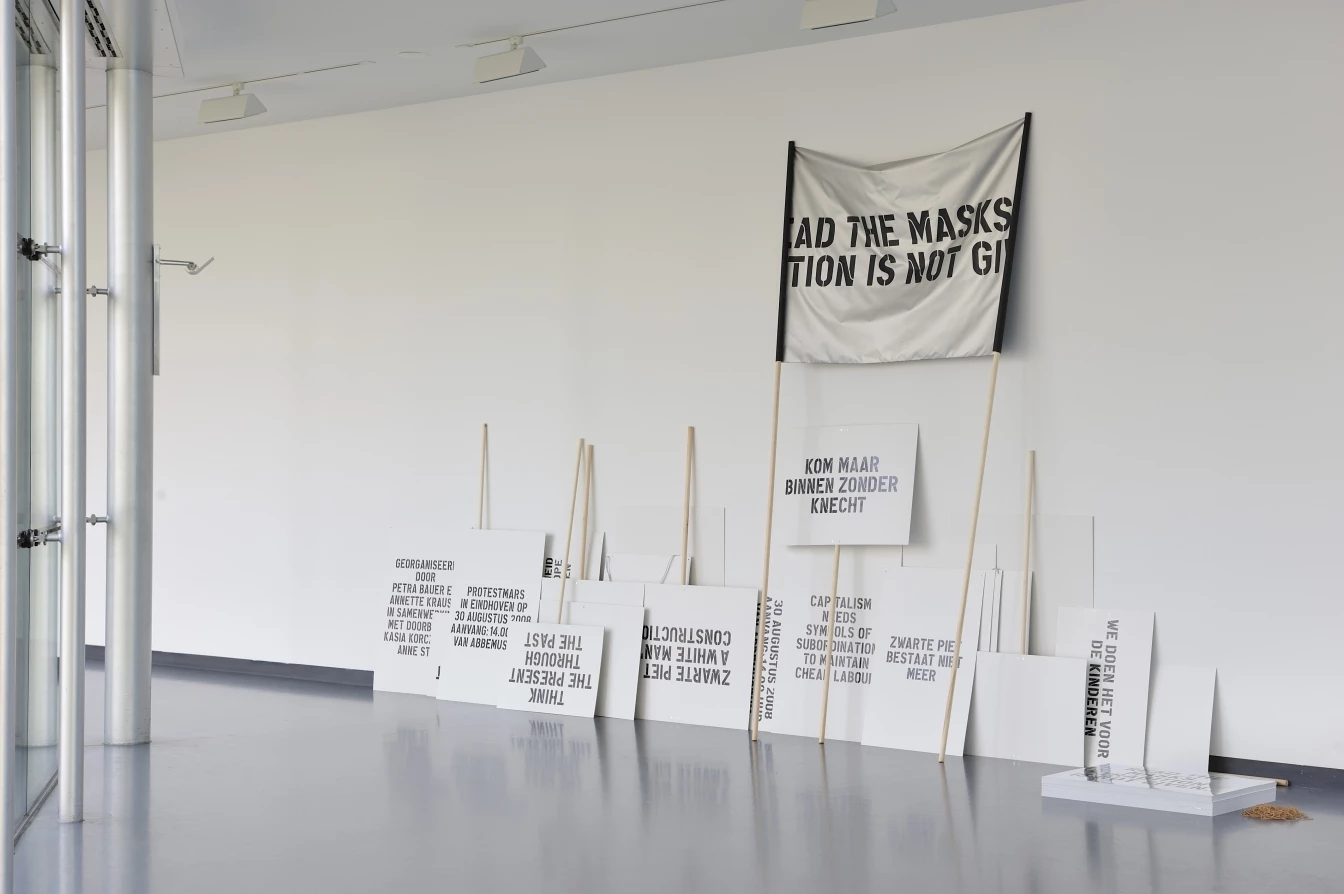
Petra Bauer and Annette Krauss, Read the Masks. Tradition is not Given, 2008–9. In the exhibition Be(com)ing Dutch (24 May 2008 – 14 September 2008). Courtesy: Van Abbemuseum, Eindhoven. Photographer: Peter Cox.
Zwarte Piet, Yes or No. Can we talk about it?
Petra Bauer and Annette Krauss's Read the Masks. Tradition is not Given (2008–9), in the exhibition Be(com)ing Dutch (24 May 2008 – 14 September 2008)
In the past fifty years, there have been various protests against the depiction of Zwarte Piet (Black Peter) in the traditional Sinterklaas (Saint Nicolas) festivities in The Netherlands. Its colonial past and racist structure has been brought to the surface. The feast of Sinterklaas is one of the most celebrated Dutch traditions. In mid-November, Sinterklaas arrives to The Netherlands by boat (an event broadcast on national television) to bring gifts to the children. He is accompanied by numerous Zwarte Pieten, his black-faced assistants with red lips and dark curly hair. While this tradition is cherished in the collective memory of The Netherlands – and by the country's retailers –, the problematic aspects of the figure of Zwarte Piet have only rarely been discussed in the mainstream media, since any attempts have generally encountered immediate disparagement or ridicule.
In 2008, artists Petra Bauer and Annette Krauss wanted to re-open the debate concerning this 'blacked-up' figure, and in doing so re-open the discussion about a cultural tradition which is depolitisised, neutralised and incorporated in the collective mind of current society. As in the case of previous protests, this lead to popular opposition from people who wished to maintain this 'typical Dutch' tradition.
As part of the Be(com)ing Dutch project, the museum commissioned the artists to develop a project in several stages – an installation, a protest march and a film to depict the debate on the phenomenon and suggest an alternative way to enjoy the festivities. They organised a performance march in which a different kind of procession was prepared and proposed.
Bauer and Krauss intended to explore the Zwarte Piet phenomenon from the perspective of people from minority cultures who are also citizens of The Netherlands. The march was to take place in the city centre of Eindhoven on 30 August 2008. Due to extremely negative reactions and threats of violence, the Van Abbemuseum found itself forced to cancel the march.
The film Read the Masks. Tradition is not Given contains footage of the debate which was organised by the museum addressing the question "Zwarte Piet, Yes or No. Can we talk about it?", and interviews. It forms a dramatic story on the position of the museum when it deals with issues of everyday life and art, and struggles to push freedom of speech on extremely 'unpopular' issues.
–Diana Franssen, Member of the Editorial Board L'Internationale Online, Curator at the Van Abbemuseum, Eindhoven

From the exhibition It was a time of conversation, SALT Ulus, 2013. Photo: Cemil Batur Gökçeer.

From the exhibition It was a time of conversation, SALT Ulus, 2013. Photo: Cemil Batur Gökçeer.
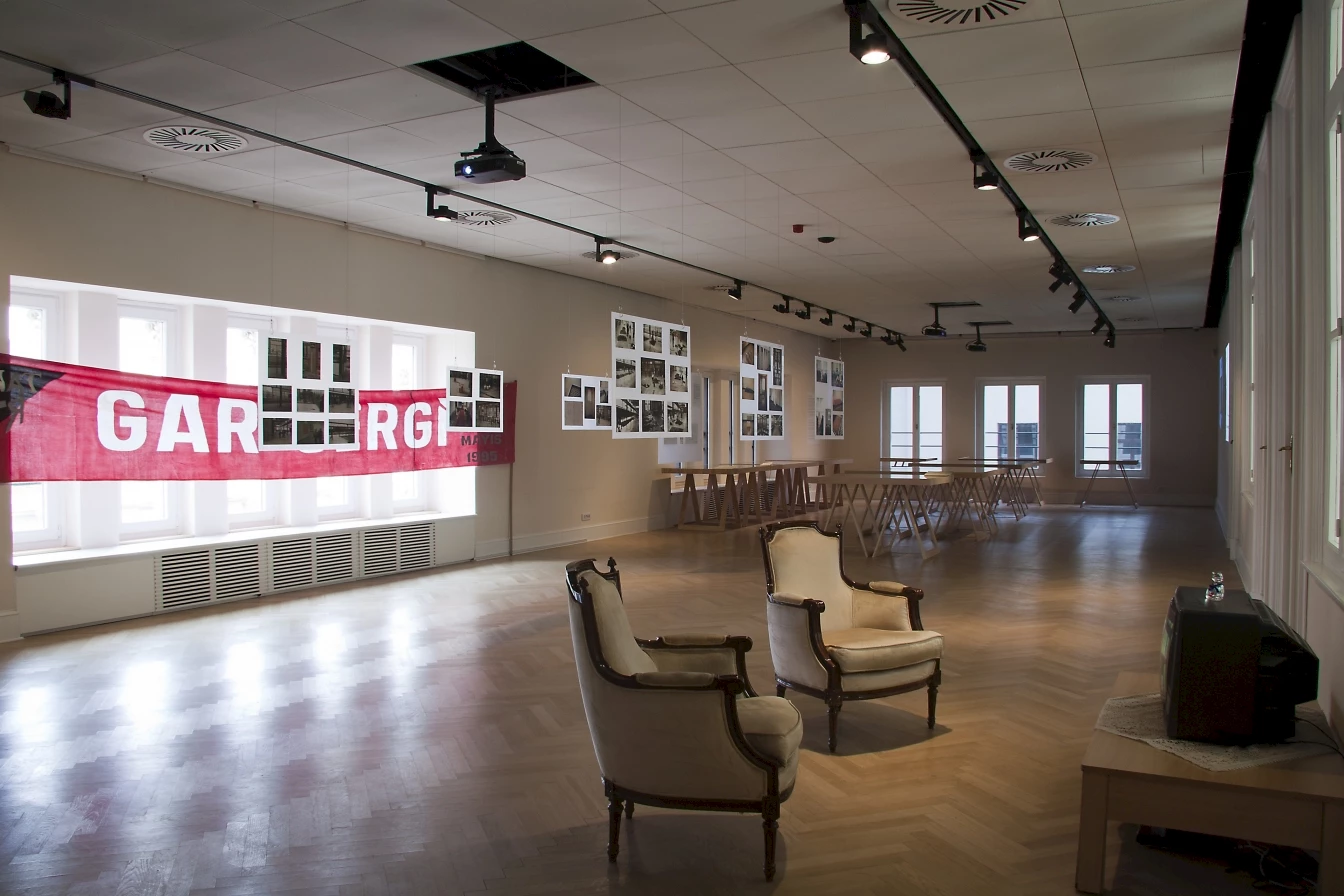
From the exhibition It was a time of conversation, SALT Galata, 2012. Photo: Mustafa Hazneci.
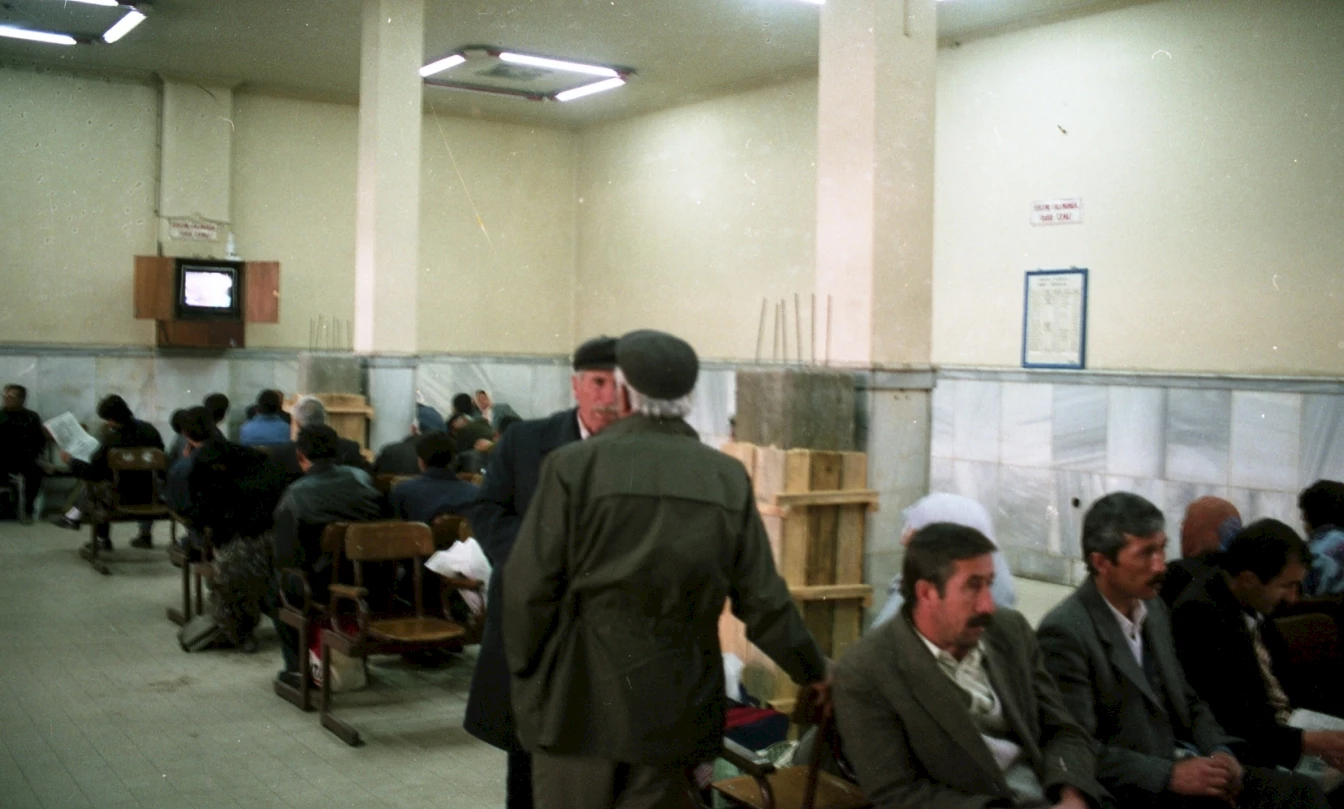
From the exhibition GAR [Railway Station], Ankara Railway Station, 1995. SALT Research, Exhibition Archive of Turkey.
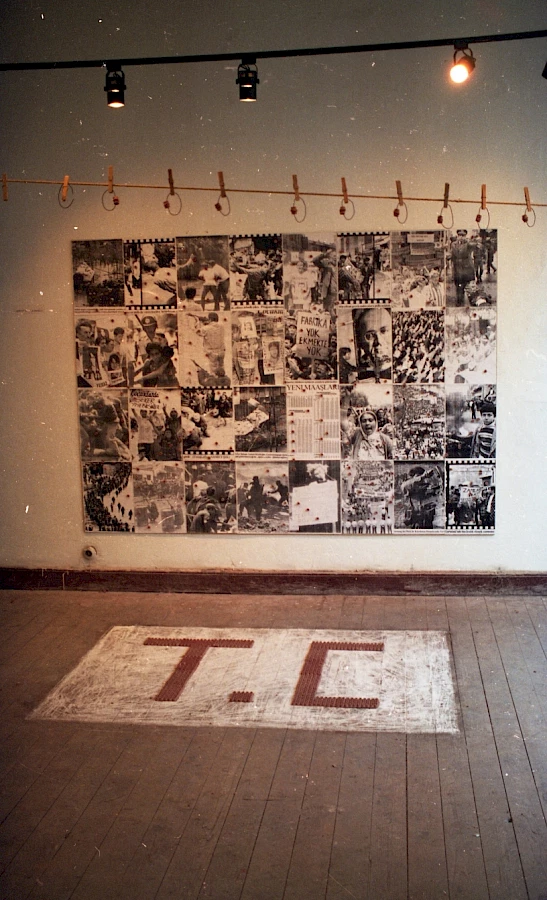
Ahmet Müderrisoğlu, in Untitled, Globalization–State, Misery, Violence exhibition (Istanbul), 1995. SALT Research, Exhibition Archive of Turkey.
FROM THE ARCHIVES OF SALT, ISTANBUL
It was a time of conversation
It was a time of conversation was a research project exhibited at SALT Galata (Istanbul, 2012) and SALT Ulus (Ankara, 2013). The project began with the extensive research and compilation of archives concerning three exhibitions that took place in the first half of the 1990s in Turkey: Number Fifty / Memory/ Recollection II, GAR, and Globalization—State, Misery, Violence. It was a time of conversation reevaluated these curatorial and collective projects, which were all organised during a period when art itself emerged as an object of knowledge, intersected with other disciplines such as sociology and politics. It referenced curators, sociologists, artists and specialists who within their independent fields were beginning to understand artistic practice as a “form of conversation”. Number Fifty / Memory/Recollection II was curated by Vasif Kortun in 1993. When the exhibition banner was replaced by a poster for a political party, Kortun and the participants decided to close the exhibition prematurely. GAR was organised at the Ankara Railway Station in 1995, a collective initiative by the involved artists. The works included in GAR were removed by the Station Directorate a day after the exhibition opening. Curated by Ali Akay in 1995, Globalization—State, Misery, Violence focused on state violence, violence against the state and violence among individuals responding to the political situation in Turkey at the time. Using the archives of these three exhibitions as a departure point, It was a time of conversation offered a new perspective on art in Turkey during the 1990s. The archives of these exhibitions became accessible at SALT Research and an e-book was published.
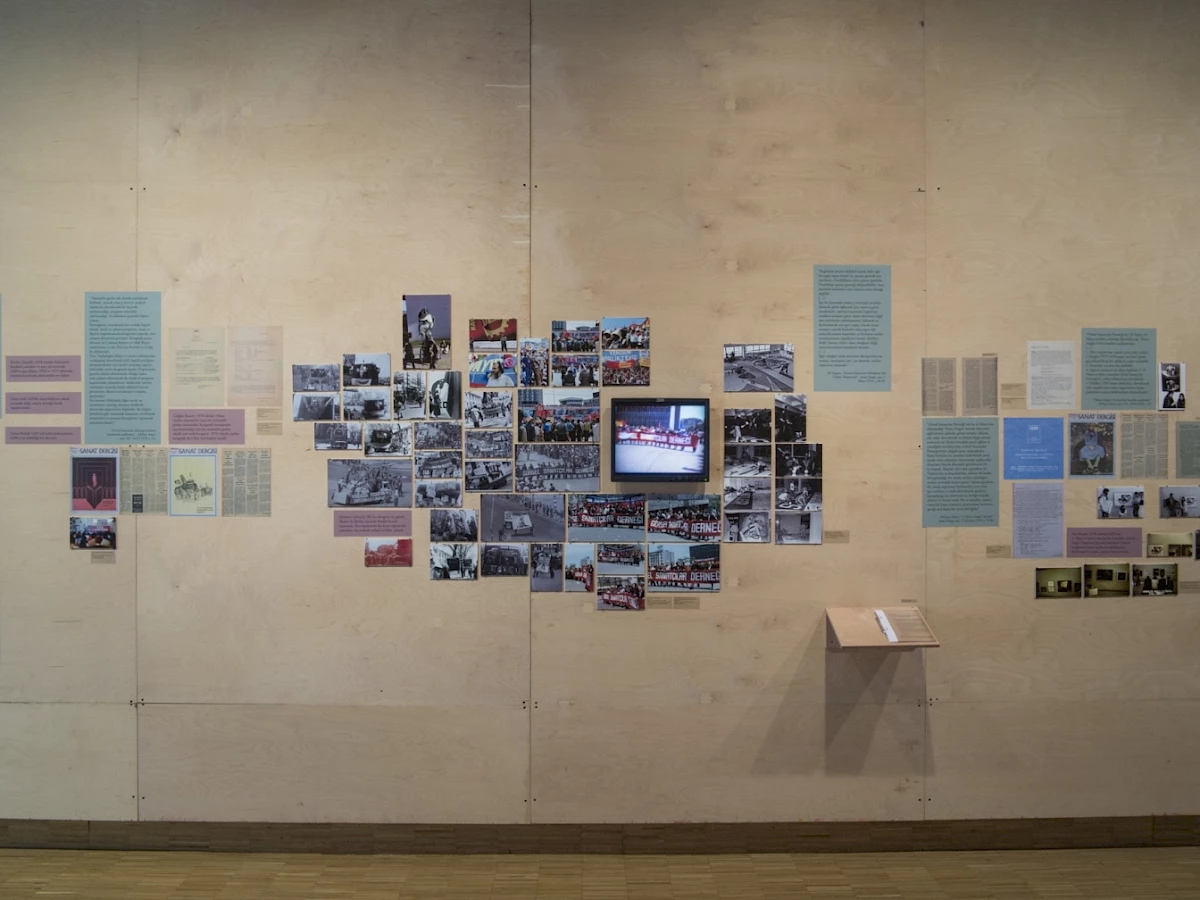
From the exhibition Scared of Murals, SALT Beyoğlu, 2013.
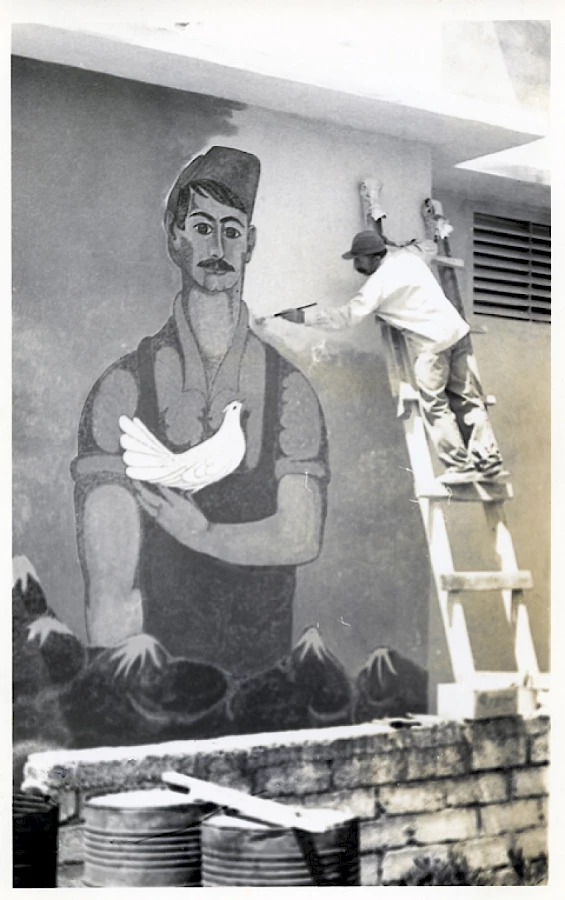
13th Antalya International Film and Arts Festival, 1976. SALT Research, Scared of Murals Archive.
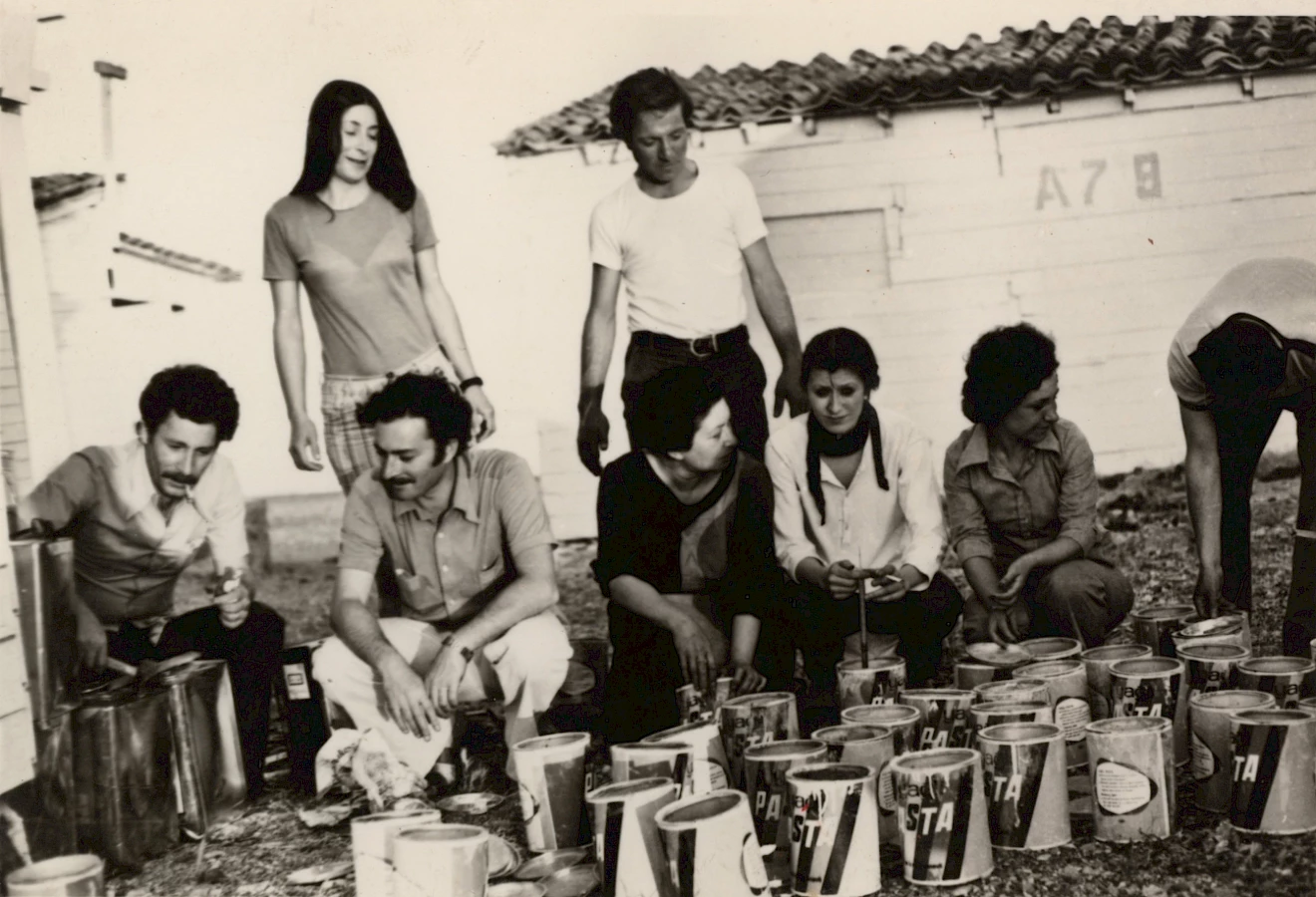
Preparation of paint for the murals (Konyaaltı, Antalya). SALT Research, Scared of Murals Archive.
Scared of Murals
The exhibition Scared of Murals that took place at SALT Beyoğlu in 2013 originated in the digitisation of the archive of Ahmet Öktem's work which is accessible at SALT Research. Scared of Murals was a research project examining the politicisation and unionisation of artists between 1976 and 1980.
A plethora of documentary material was presented in the exhibition, restaging elements from specific exhibitions that took place during this period, and particularly the 1. Mayıs Sergisi [First May Exhibition] organised by the Visual Artists Association. The project revisited issues of artists' rights, involvement and collaborations with workers' unions, and the function and positioning of art in the public sphere. Öktem had photographed the First May Exhibition in 1977. The interviews with artists and with people who experienced the Massacres on 1 May 1977 on Taksim Square led in due course to further research on the artists' unions and the processes of politicisation at that time. All of these materials have become part of SALT Research. Two research publications brought together articles on cultural production, state politics, censorship and artists' unions between 1976 and 1980.
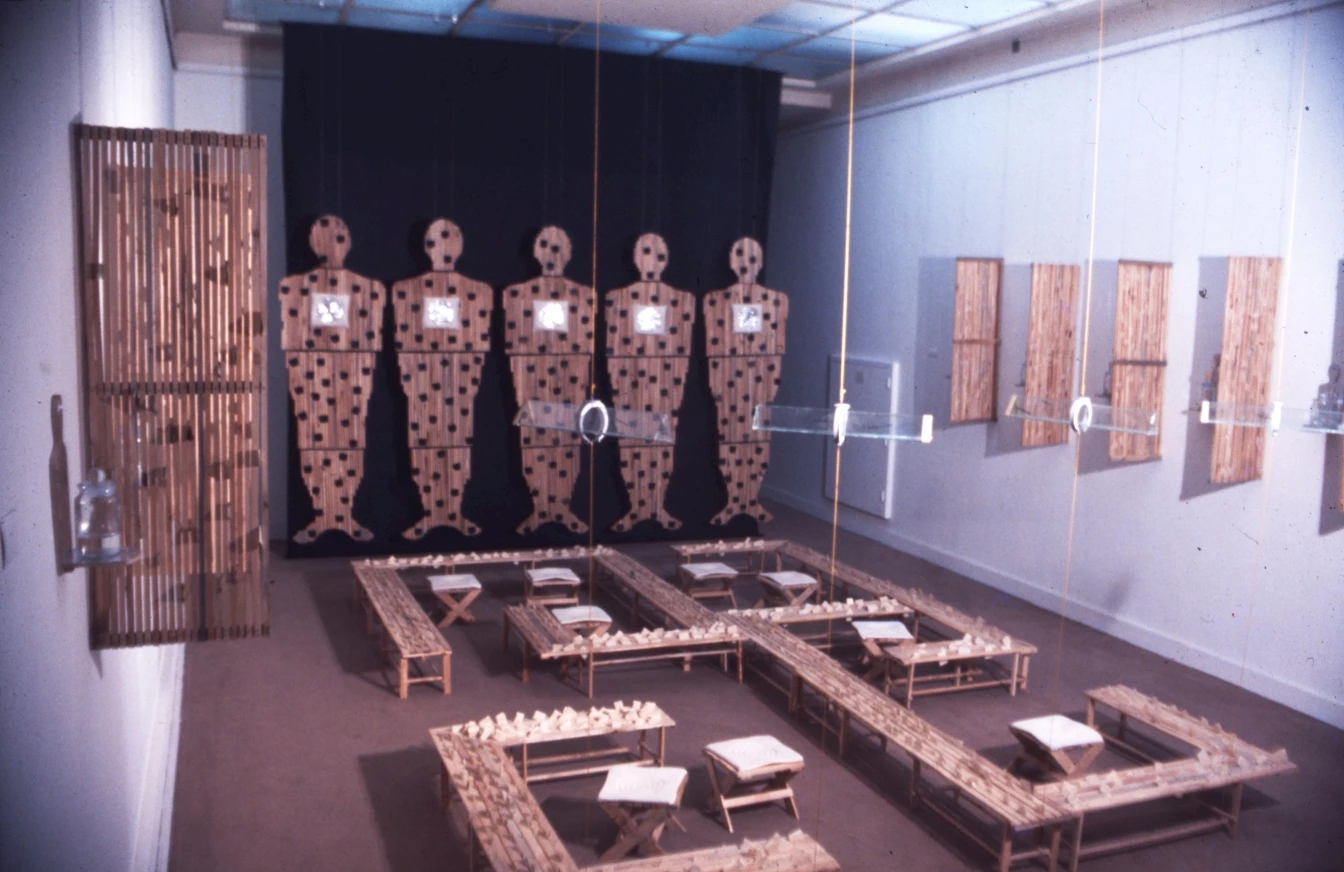
İsmail Saray, ER-DAMU-UTU-SU, Paris Biennale, 1977. SALT Research, İsmail Saray Archive.
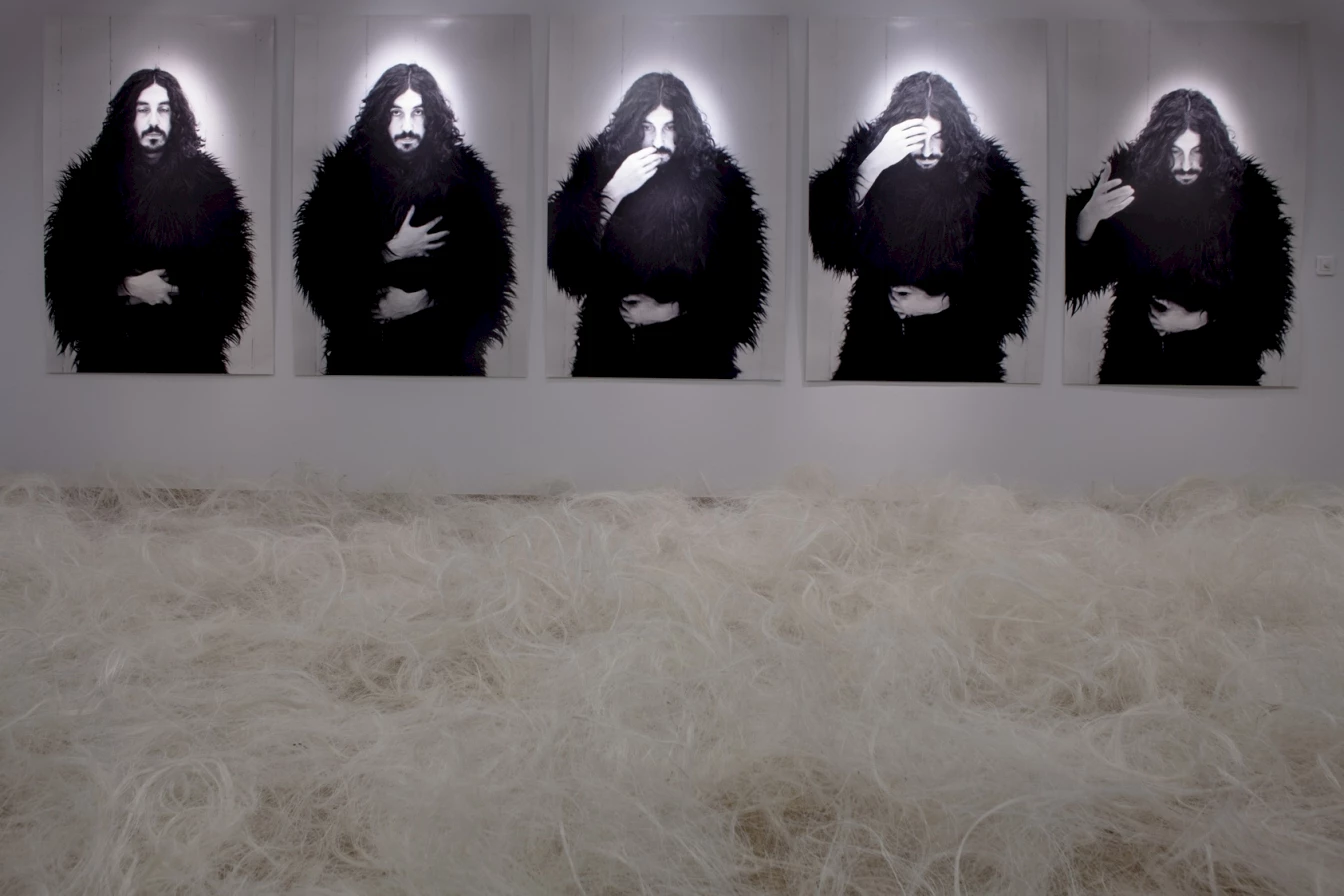
From the exhibition From England with Love. İsmail Saray, SALT Ulus, 2014–2015. Photo: Cemil Batur Gökçeer.
İsmail Saray Research Project
The artist İsmail Saray (b.1943, Kütahya) holds a crucial place in the advanced art of the 1970s and early 1980s in Turkey, as a pioneering artist in conceptual practice. The significance of his work has yet to be duly acknowledged in local and international art history. There were very few texts, no books, and no exhibition catalogues on Saray's practice. An in-depth collaboration with the artist, İsmail Saray Project was comprehensive, two-year research comprising the identification of materials, archiving and digitising. The project began with assembling and securing the artist's complete archive, as well as unearthing various artworks kept by Saray's fellow artists. A digitised archive composed of works, documents and other materials became accessible to the public through SALT Research. The exhibition From England with Love. İsmail Saray at SALT Galata and SALT Ulus in 2014 introduced the first phase of research. An e-book in parallel with the project will be published.
–Sezin Romi, Programmer at SALT, Istanbul
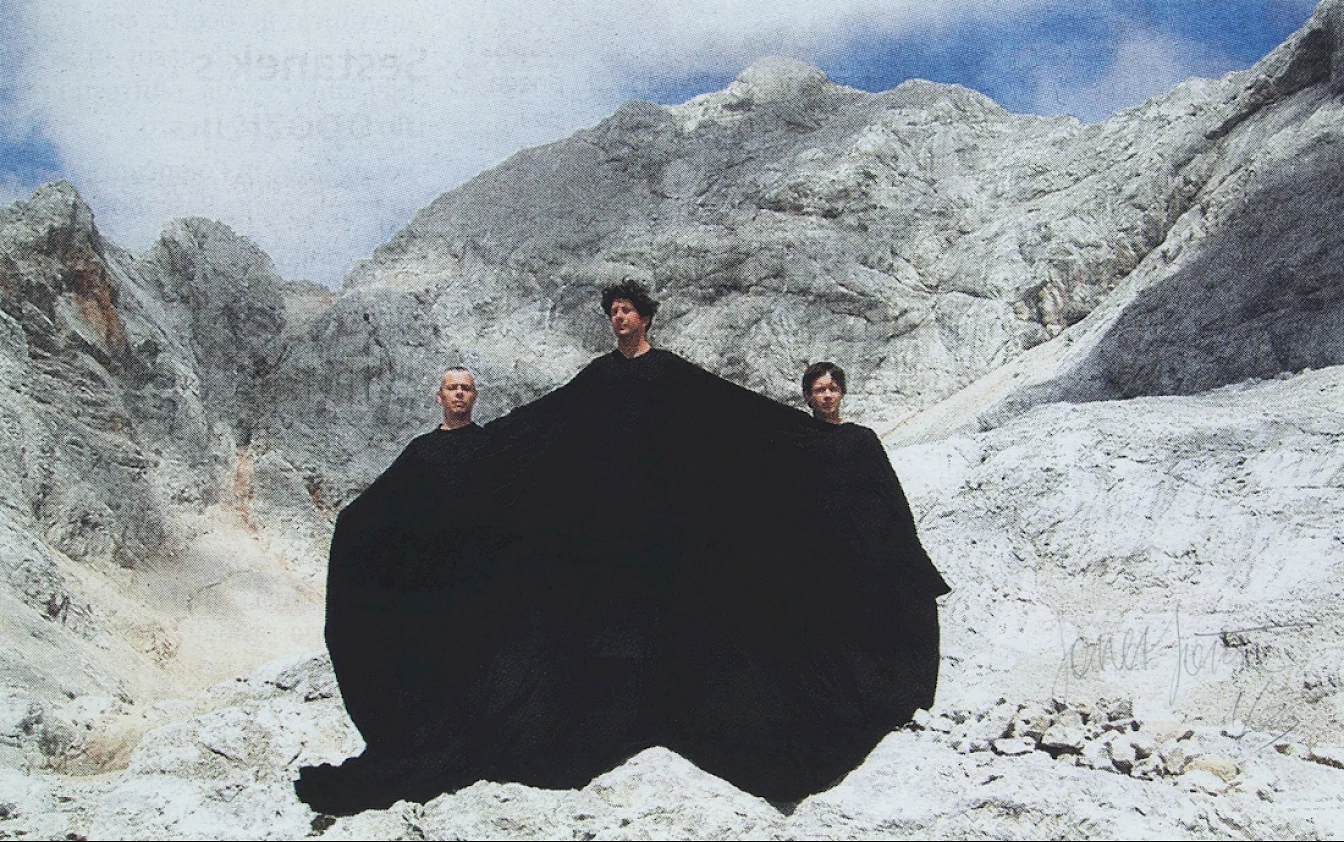
Janez Janša, Janez Janša, Janez Janša, Mount Triglav on Mount Triglav, 2007. Digital prints, 70 x 111 cm. Courtesy Moderna galerija, Ljubljana.
FROM THE COLLECTION OF MG+MSUM, LJUBLJANA
Janez Janša, Janez Janša, Janez Janša
Mount Triglav on Mount Triglav, 2007
Digital prints, 70 x 106 cm, 70 x 111 cm, 70 x 87.5 cm
Collection of Moderna galerija, Ljubljana
Soon after changing their names to that of a former Slovenian Prime Minister, the three Janez Janšas staged their first show entitled Triglav at the Mala galerija in Ljubljana (2007), dedicating it to the local tradition of collective practices. They presented the 1968 performance Mt Triglav by the group OHO and its two reenactments: the one by the group Irwin in 2004 and their own in 2007.
Crucial to all three groups of artists was the significance of Mt Triglav (meaning the "three-headed" mountain) as a Slovene national symbol. Three members of the OHO group "enacted" Mt Triglav by draping black fabric over their bodies so that only their heads jutted out. Just like the three peaks of the mountain, the middle head was higher up than the lateral two, which were more or less level. The action was carried out in the centre of Ljubljana, and affected the passersby primarily with its absurdity in comparison with ordinary day-to-day socialist life. The group Irwin chose the same location for their reenactment of the performance, but intended it primarily for the lens of the camera: crucial in their case was the artefact – a good-quality, nicely framed photograph. The material dimension of the work underscored the underrated status of the neo-avant-garde line in the history of Slovene art, as well as the absence of a developed art market and related interest in a professional and standardised presentation of art. The three Janšas had their photograph taken similarly draped in black fabric, but on the mountain itself, and subsequently had the photograph printed on paper that had newspaper sheets from the three leading Slovenian dailies on the back; they were interested in the newspapers as chroniclers of various state anniversaries and events important on state level.
–Igor Španjol, Curator at MG+MSUM, Ljubljana